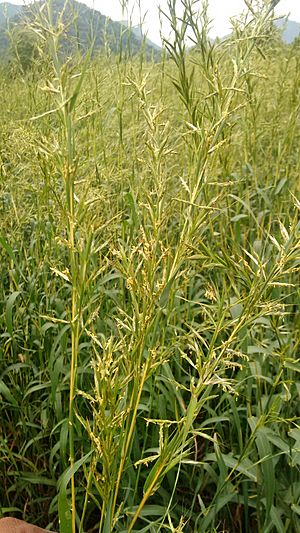Cymbopogon martinii facts for kids
Quick facts for kids Cymbopogon martinii |
|
|---|---|
| Scientific classification | |
| Genus: |
Cymbopogon
|
| Species: |
martinii
|
| Synonyms | |
|
|
Cymbopogon martinii is a type of grass that belongs to the Cymbopogon family, which also includes lemongrass. This plant originally comes from India and Indochina. However, it is now grown in many other places because of its special, sweet-smelling oil.
Most people know this grass as palmarosa, which means "palm rose." This name fits because the oil from the plant smells a lot like roses. Other common names for it are Indian geranium, gingergrass, and rosha grass.
Contents
What is Palmarosa Oil Used For?
The essential oil from the palmarosa plant contains a chemical called geraniol. This oil is very popular because of its lovely smell. It also has many traditional uses in medicine and around the house.
Palmarosa oil can act as a natural insect repellent. It helps keep bugs away from stored grains and beans. It also works against tiny worms called nematodes. Plus, it can fight off fungi and keep mosquitoes away.
Because palmarosa oil smells so much like roses, it is often added to soaps and cosmetics. This gives these products a pleasant, floral scent.
How Palmarosa is Grown
This grass can grow quite tall, usually between 1.3 and 3 meters (about 4 to 10 feet) high. It has a light green color and a strong, thin stem.
Palmarosa grows slowly, taking about three months to flower. Once the flowers appear, the plant is ready to be harvested. The name "palmarosa" comes from the sweet, rose-like smell it gives off. This scent makes it a popular ingredient in perfumes and cosmetics worldwide.
Besides its use in beauty products, palmarosa is also known to help repel mosquitoes. It can even be used to add flavor to tobacco products. In some cultures, it has been used in traditional remedies and for aromatherapy, which uses plant extracts for health and well-being.
Where and How Palmarosa Oil is Made
Palmarosa grows naturally in wet areas, especially in parts of India and Nepal. To get the valuable palmarosa oil, it is taken from the plant's stem and leaves.
This is done through a process called distillation. The dried stems and leaves are heated with steam for two to three hours. This separates the oil from the plant material. After the oil is collected, the leftover plant parts are often used as organic fertilizer or compost. This helps new plants grow.
Best Conditions for Growing Palmarosa
The best way to grow palmarosa is in a special nursery. It needs a lot of water and soil with a pH level between 7 and 8.
A few days before planting, farmers often soak the soil with water. This makes sure the soil is very moist, above 60% moisture, when the seeds are planted. High moisture helps the seeds sprout better and also helps control weeds in the nursery beds. It's also a good idea to flood the soil once a month to keep it moist. Watering in the nursery is most important during the first 40 days.
Palmarosa grass grows well in sandy soil. It doesn't need a lot of nitrogen, but it does need enough phosphorus and potassium. Weeds can be a big problem, so keeping them out of the nursery beds helps the plants grow better. Weeding is often done by hand, which requires careful work.
Farmers sometimes plant palmarosa with other crops, like pigeon pea, millet, or sorghum. This is called intercropping. It helps to keep weeds down and makes the land more efficient. Since palmarosa can be harvested three or four times a year, intercropping works well.
Why Nurseries are Important
Growing palmarosa in a nursery is very important. Without one, the plants might not grow well, and farmers might not make a profit. Setting up a nursery can be costly, which can be a challenge for some farmers.
If palmarosa is not grown in a nursery, farmers will spend much more time weeding their fields. This can increase weeding work by over 70% and lead to smaller harvests. So, even though a nursery costs money to start, it usually helps farmers get a better return on their hard work.
Palmarosa as an Antifungal
Palmarosa oil has properties that fight against fungi. It can help stop the growth of common molds like Aspergillus niger (known as black mold) and Chaetomium globosum (often found in moldy soil). It also works against Penicillium funiculosum, which is a plant disease.
Palmarosa as an Insect Repellent
As mentioned, palmarosa is used to keep insects away. Its natural properties make it a useful repellent.
See also
 In Spanish: Palmarosa para niños
In Spanish: Palmarosa para niños


